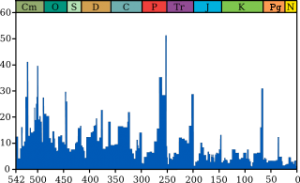TRUTH IS SEGMENTED BY METHOD OF OBSERVATION AND/OR DEDUCTION USED TO GATHER THE INFORMATION.
We are in the beginning of the 6th mass extinction of species that this planet has experienced. It may be wise to try and figure out what happened the last five times… maybe?!?
 The blue graph shows the apparent percentage (not the absolute number) of marine animal genera becoming extinct during any given time interval. It does not represent all marine species, just those that are readily fossilized. The labels of the traditional “Big Five” extinction events and the more recently recognised End-Capitanian extinction event are clickable hyperlinks. (source and image info)
The blue graph shows the apparent percentage (not the absolute number) of marine animal genera becoming extinct during any given time interval. It does not represent all marine species, just those that are readily fossilized. The labels of the traditional “Big Five” extinction events and the more recently recognised End-Capitanian extinction event are clickable hyperlinks. (source and image info)
SCIENTIFIC
METHOD:
What is Scientific Method?
The scientific method is the process of turning a guess (regarding an observation)… into a tested theory about this physical world.
Process:
- Form a question about an observation.
- Form an educated guess which may answer that question.
- Form a prediction of a result of that guess being observed (before testing).
- Test that prediction through a simulation/experiment or observational/field study.
- Analyze the data from the test, and either revise the guess or form a new one and repeat the process.
Final Step – record findings, and share:
- Write a descriptive method of observation and the results or conclusions reached.
- Have peers with experience researching the same phenomenon evaluate the result.
- Share the information gathered for others to build upon.
HOW DO WE GET TO
MILLIONS OF YEARS:
MANY TYPES OF SCIENCE COMBINE, WITH EACH BEING LAYERED BY “THE OLDEST IS ON THE BOTTOM” TECHNIQUE.
HERE ARE SOME OF THE OTHER METHODS:
Cosmogenic Radio-isotopic Dating:
Radio-isotopic dating follows rocks process of decaying. This releases energy (in the form of radiation) and often changes one element into another.
Rubidium–Strontium dating:
Development of this process was aided by German chemists Otto Hahn and Fritz Strassmann, who later went on to discover nuclear fission in December 1938.
The utility of the rubidium–strontium isotope system results from the fact that 87Rb (one of two naturally occurring isotopes of rubidium) decays to 87Sr with a half-life of 49.23 billion years. In addition, Rb is a highly incompatible element that, during partial melting of the Earth’s crust, joins the lava melt (rather than remaining in crust minerals). As a result, Rb is enriched in crustal rocks.
The radiogenic daughter, 87Sr, is produced in this decay process and was produced in rounds of stellar nucleosynthesis predating the creation of the Solar System.
Volcano Ash (Tephrochronology):
Tephrochronology is uses volcanic ash from a single eruption—to create a time bookmark for that eruption.
The premise of the technique is that each volcanic event produces ash with a unique chemical “fingerprint” that allows the deposit to be identified across the area affected by fallout. Thus, once the volcanic event has been independently dated, the bookmark (aka. “tephra horizon”) will act as time marker.
This ash can be found in paleo-environmental or archaeological records.
Tree-ring Dating (Dendrochronology)
Dendrochronology (or tree-ring dating) is the scientific method of dating tree rings (also called growth rings) to the exact year they were formed in order to analyze atmospheric conditions during different periods in history.
North/South Pole switching history (Paleomagnetism)
Certain minerals in rocks lock-in a record of the direction and intensity of the magnetic field when they form. Paleomagnetism (or palaeomagnetism in the United Kingdom) is the study of the record of the Earth’s magnetic field in rocks, sediment, or archeological materials.
Paleogeography
Palaeogeography is the study of historical geography, generally physical landscapes, including human or cultural environments. When the focus is specifically on the study of landforms, the term paleogeomorphology is sometimes used instead.
Processes Tracked for Dating:
- Uranium–lead
- Samarium–neodymium
- Potassium–argon
- Rubidium–strontium
- Uranium–thorium
- Radiocarbon
- Fission track
- Chlorine-36
- Luminescence
- The 129I – 129Xe chronometer
- The 26Al – 26Mg chronometer
- Other methods
